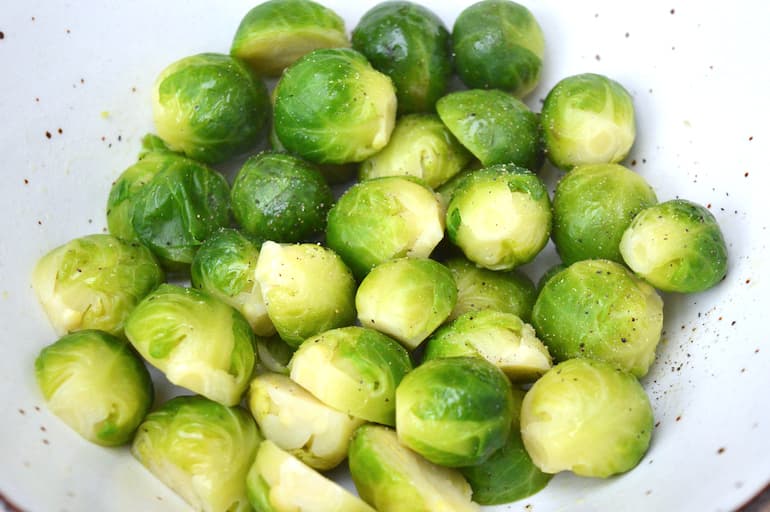The Childhood Terror That Turned Kind Of Nice
If you’re a child of the 1970s or early-to-mid 1980s or so, there are a few things you probably fear that children of today barely think twice about. At the top of that list, of course, is quicksand. (If you’re not a child of that time period, ask someone who is.) But only slightly below quicksand on that list is something just as scary, albeit not nearly quite as deadly — our worst fears notwithstanding: the hideous creatures seen below.
Yes, those are Brussels sprouts.
They don’t look so terrible right now — hardly. But go back forty plus years and they were the bane of childhood dinner times. Parents wanted their kids to eat their vegetables, as parents of today still do. And kids would rather eat pasta, pizza, or even candy for dinner — as, again, kids of today still do. Anything green gave kids pause, sure, but these mini cabbages were particularly hated. A dive into the newspapers of the day demonstrates the point. When the American Cancer Society announced that Brussels sprouts “may inhibit cancer” in 1983, newspapers shared this unequivocally good news by joking that “kids may think this is the worst thing to happen since Popeye endorsed spinach.” A columnist in 1985, noting how new parents were hiding vegetables in otherwise palatable foods, conceded that Brussels sprouts were “cursed” and no child would ever eat then. A comedian from 1987 suggested that you were more likely to get your kids to mow your lawn with their mouths than to eat the foul sprouts. A columnist from 1987 said that if you want to get your kids to help clean the house, you can “threatening the kids with [Brussels] sprouts for supper” was a workable strategy. And the list goes on.
But today, Brussels sprouts are a welcome addition to any dinner, and have a particularly prominent place at the Thanksgiving table and other fall family gatherings. Part of what changed is our palettes — as we grow up, we tend to like foods we didn’t (and can’t tolerate some that we used to love). Recipes have also changed — in the 1980s, Brussels sprouts were typically served steamed, which isn’t great; as any foodie will tell you today, they’re better roasted, particularly with some sort of balsamic glaze or garlic. (I make them with both, plus shallots and, if the mood strikes, cannellini beans.) But the real change isn’t us or our cooking skills. It’s the sprouts themselves.
There are lots of reasons why the steamed Brussels sprouts of the 1980s were so loathed — they were good for us, yes, but they were soggy, smelled kind of like old socks, and most importantly, they were very, very bitter. Preparation techniques can address the former two but any cook is only as good as their ingredients allow. So in the 1990s, a Dutch scientist named Hans van Doorn decided to fix the bitterness problem. As NPR reported, he and his team “figured out exactly which chemical compounds in spruitjes [the Dutch word for sprouts; they don’t acknowledge the alleged connection to nearby Brussels] made them bitter.” Those chemical compounds, called glucosinolates, are “what give sprouts—and other cruciferous vegetables like broccoli, kale, and cabbage—a bitter flavor,” per Better Homes & Gardens. Doorn realized that if he could find a variety of Brussels sprouts that had lower levels of glucosinolates, he could make better-tasting vegetables.
That turned out to be easier than expected. One of the companies that sold Brussels sprouts seeds in the area, Bejo Zaden, didn’t just sell seeds — they also housed a living history of the plants. As Cees Sintenie, a plant breeder for Bejo Zaden, explained to NPR, “We have a whole gene bank here in our cellars, with all the possible Brussels sprouts varieties that were available from the past.” Doorn was able to locate a few potential candidates for the future of sprouts — all the team needed to do, after that, was figure out a way to grow lots and lots of them. Science provided a solution to that problem, too. As Better Homes & Gardens explains, “Once the most promising varieties were identified, plant breeders crossed them with newer varieties that had other desirable characteristics such as higher yields and excellent disease resistance. The resulting varieties have proven popular with both farmers and chefs and ultimately anyone who eats them.”
So for anyone who now loves Brussels sprouts but hated them as kids, don’t blame yourself if you refused — the sprouts of your childhood were, indeed, awful. Science — not your parents (sorry, moms and dads!) — got you to eat them.
Bonus fact: Almost all the cabbage-like food we eat is all from the same species of a wild mustard plant known as Brassica oleracea. As Wikipedia’s editors note, it has a lot of cultivars: “cabbage, broccoli, cauliflower, kale, Brussels sprouts, collard greens, Savoy cabbage, kohlrabi, and gai lan” all are different varieties of B. oleracea. In total, more than two dozen different types of cultivars (that we eat) come from this one plant species.
From the Archives: Sprouted: There are some people who really like Brussels sprouts. It’s not the chef, not the ingredients. It’s genetics.

